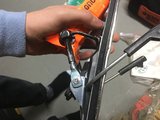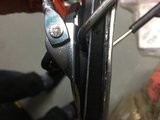freestyler540Heres the science on edge cracks:
Its caused by heat stress by the metal on metal friction, heating a section of the rail, then getting quenched by the cold snow. Do it enough times and the inter-granular bonding breaks down in the steel, causing it to warp and crack. The edge begins to pull out from the friction of the steel-steel contact because of the resistance force pulling the edge in the backward direction.
The best way to help with cracking is to round out the edge as smoothly as possible. The first reason is sharp corners gather more heat faster because of lack of surface area and are more brittle than dull surfaces. Rounding out the edge will increase the surface area of contact and dissipate the heat over a wider area. It will also make the edge stronger overall.
Sure, it sounds bad. But thats why you should have a pair of park skis and a pair of turn skis. Your turn skis should never ride a box or rail until it retires. Keep the turn skis super tuned and keep the park skis detuned and waxed.
Now to deal with core rot. Depending on the topsheet material and base, they do crack over time. Around the screws of the bindings, snow can accumulate, melt and seep into the core. Do you leave your skis in the car all winter long outside? Congrats! you did the best thing to kill a ski. Cars are bad for humidity and the melt occurs as you drive home. Leave it in the car overnight and the water freezes in the ski; destroying the core. Same goes with cracked edges. Store your skis indoors all the time in a dark, dry location and it will be fine. Wood cores are prone to root due to the nature of wood. Keep them dry!
Hope this helps in the future.
Source? This seems to be written purely on speculation without any actually scientific testing.
How hot does an edge get when you slide a rail?
How hot does an edge need to be to warp?
How much of a temperature difference is need for steel to exhibit significantly reduced bond strength?
Does steel work harden? Some metals do, some don't.
If steel work hardens could the edge cracking not be from the increase in brittleness?
Does steel need a temperature change to work harden?
Temperature might have nothing to do with it and simply the forces being put on the edges cause it to work harden and become more brittle and crack. Obviously heat is produced in this process, but is heat just an insignificant byproduct or is heat the whole reason it's happening?
Edges are hardened to some extent already, is the amount of heating/cooling that does happens to them when you slide a rail enough to harden them more or does it actually cause them to loose their temper and become softer?
So many questions to be answered about this. I don't believe your explanation can be said as fact without actually doing testing.
Then you say lack of surface area means more heat? Only if the surface area that is touching has a friction coefficient is high enough to compensate for the smaller surface area. If the friction coefficient is the same (it should be similar, being that it's the same material) then less surface area means less heat. Does angle affect friction coefficient? Actually I'm thinking given all things equal if an edge is sharp with less surface area touching the rail vs dull with more, there will be the exact same amount of heat generated. The heat dissipation makes sense.
Does the shape of the edge actually make a difference in how brittle it is? I wouldn't think so.
Also if your bindings are properly mounted with some glue or whatever to seal the screw hole then leaving them wet or dry will make no difference (so long as it is properly sealed with something that isn't broken down by moisture). If water can't get to your core it can't rot your core.
Also foam cores rot too.
Not trying to be a dick, just this is how misinformation is spread. It just seems a little too wishy-washy to be from an actual study and seems like it's entirely conjecture. If you have a primary source I would love to read it.















